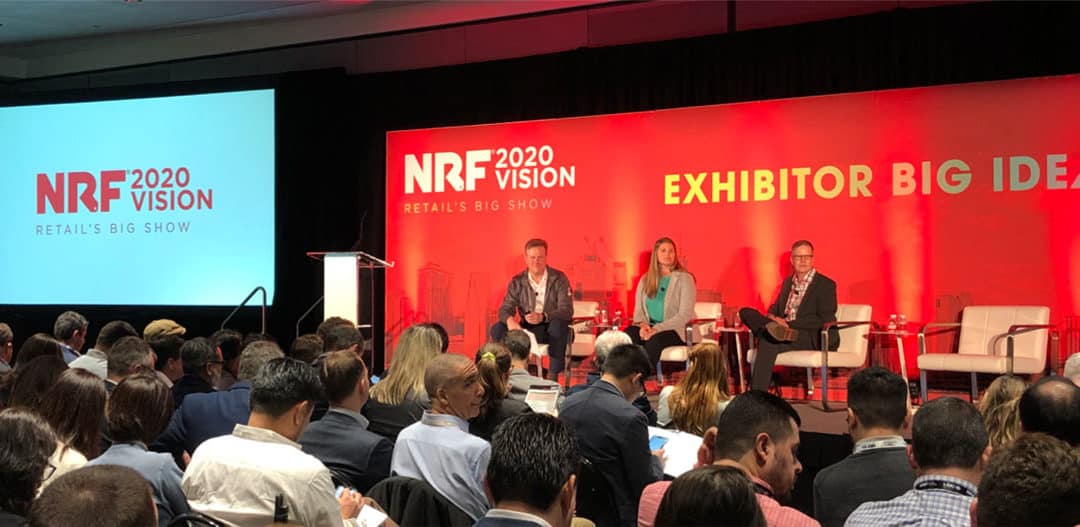A Recap of One Door’s Big Ideas Session from NRF 2020
When we talk to retailers around the world, one thing is clear: everybody thinks they’re behind when it comes to planogram automation and merchandising execution. At NRF 2020, we set out to discover how space planning and merchandising are evolving with new technologies, and where retailers are in their digital transformations.
Each year, we collaborate with leading retailers like Best Buy and T-Mobile to develop Big Ideas sessions that inspire and educate our community of visual merchandisers and space planners. What we see in the retail community is a hunger to understand how digital tools can improve merchandising and reinvigorate customer experiences. For the second year in a row, we had a standing room only audience eager to learn from their peers.
For those that were not able to join us, we’ve laid out the highlights of our panel discussion with Tracy Allen, Sr. Director of Space Management at Walgreens, and Scott Heyer, former Director of Visual Merchandising at The Paper Store, below.
Tom Erskine (TE): There’s a big difference between Big Data and useful data. Tell us about that.
Tracy Allen (TA): We have so much data at Walgreens. You can imagine 9,200 stores, multiply that number in every aspect and… it’s a lot. But we had data in so many different places that it was difficult to gather and we weren’t looking at that data – whether it be sales, profit or loyalty data – relative to space. Many times, we could say, “Oh yeah, we’re up X in sales.” But we couldn’t confirm if we had grown the space by 50% and if that was contributing to the increase in sales, or if we had reduced the space.
We created our own data tables using a variety of tools that incorporate all those different data sets and bring them to the cloud. It’s allowed us to do more data visualization. Until we had all those data components together, it was hard to automate the pull of that data. Getting the right data in one place so it was easily accessible was step one. This is the benefit of using the cloud.
TE: What’s the linkage between merchandising and store quality?
Scott Heyer (SH): At The Paper Store, we saw a direct correlation between our merchandising standards and our sales performance. During the life of a store there will be personnel changes that can impact the merchandising of a store. For example, a new management team can be strong from an operational standpoint but could possibly be weaker in the visual merchandising realm – which will impact the sales numbers.
One of our key initiatives was to implement a strong in-store merchandising training program. As soon as we started getting associates engaged in the process and learning why we did what we did and how we merchandise, we started to see the sales increase, which was exciting for us. As we saw the engagement and compliance increase, we saw our sales go up.
TE: How is localization impacting your space process?
TA: Localization is a buzzword, but it’s where retailers need to go. Walgreens realizes that 9,200 stores cannot all be the same. The customers are not the same. What we’re doing from a space planning perspective to prepare for localization is automating the build of planograms. We have a partnership with Blue Yonder and we use their Planogram Generator, but last year was the first year that we actually stood it up. We just finished our first “live” reset using Plano Generator, and it’s been really successful!
For us, it’s the data component. I can’t keep bringing more people onto the team, which is what I’ve had to do over the years. The team keeps getting bigger, but it’s not efficient that way, it’s not cost-effective. I think automation is the answer to being able to unlock localization.
TE: How does mobile fit in here?
SH: Anything we can do to make it easier for the teams working inside the stores to merchandise using mobile would be key. That’s really helping drive the in-store customer experience. It’s more important than ever to have that seamless in-store experience and everything needs to be aligned.
TA: We talk about putting the visual back in visual merchandising. We’d send a black-and-white boxed diagram with numbers and writing on a piece of paper down to the store and say, “That’s how you visual merchandise.” So that’s why we started talking to One Door in the first place. We wanted to know, now that we have tablets and handhelds in all of our stores, how do we use that technology in a better way to show the store employee visually how to easily set a 33-foot vitamin set that has 600 items in it? That’s where mobile comes in.
How do you think retailers can utilize the latest technologies for visual merchandising and space planning? Learn more about One Door and schedule a demo of Our platform.

